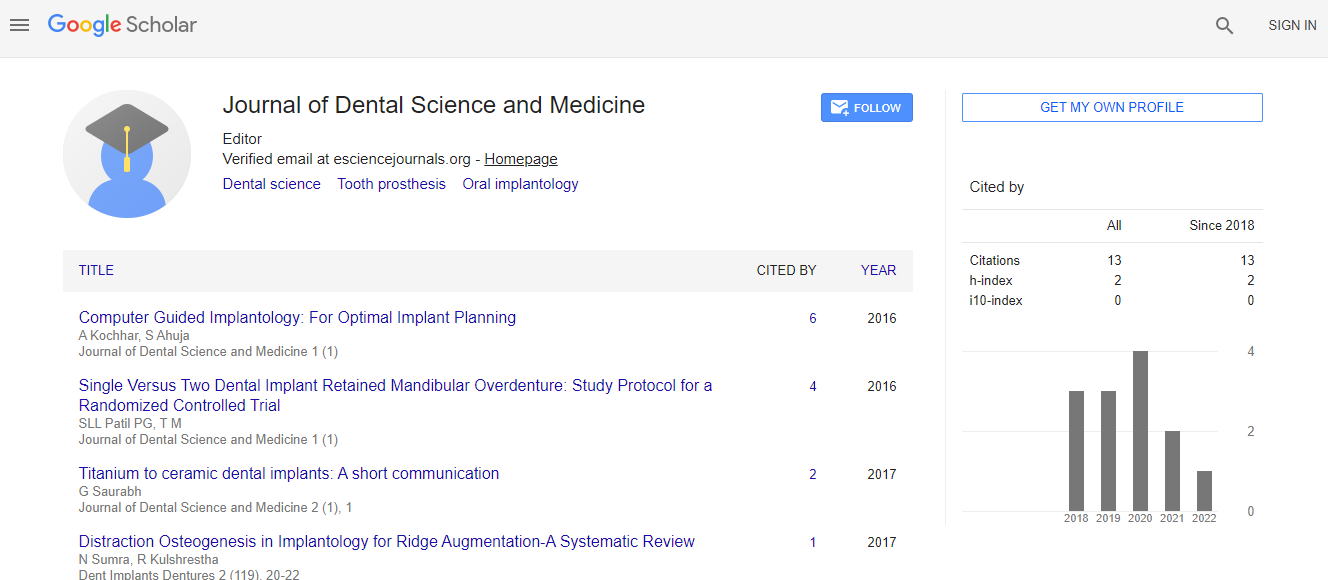Our Group organises 3000+ Global Conferenceseries Events every year across USA, Europe & Asia with support from 1000 more scientific Societies and Publishes 700+ Open Access Journals which contains over 50000 eminent personalities, reputed scientists as editorial board members.
Open Access Journals gaining more Readers and Citations
700 Journals and 15,000,000 Readers Each Journal is getting 25,000+ Readers
Google Scholar citation report
Citations : 13
Journal of Dental Science and Medicine received 13 citations as per Google Scholar report
Indexed In
- RefSeek
- Hamdard University
- EBSCO A-Z
- ICMJE
Useful Links
Recommended Journals
Related Subjects
Share This Page
Improving the dentist patients Relationship & Reflection on clinical practice
3rd Annual Modern Dentistry, Dental Practice and Research Congress & 3rd International Conference on Dental Public Health and Dental Diseases
Dr. Amolack Singh & Dr. Harmanpreet Kaur
International Dental Surgeon & Entrepreneur
ScientificTracks Abstracts: Dental Science and Medicine
Abstract
Background: Previous research & studies on relationship between doctor & patient is showing that there is strong bond between both of them. Some studies showing that patients are different types like PASSIVEDEPENDENT, INDEPENDENT-SKEPTICAL,INTELLECTUAL-RESEARCHER,EXPEDIENTFLEXIBLE, OPEN MINDED-EXPLORING. The relationship between patient and doctor has been analyzed since the early 1900's. Prior to when medicine was more science than art, physicians worked to refine their bedside manner, as cures were often impossible and treatment had limited effect. In the middle of the century when science and technology emerged, interpersonal aspects of health care were overshadowed. There is now a renewed interest in medicine as a social process. A doctor can do as much harm to a patient with the slip of a word as with the slip of a knife. But in the modern era of technology & advancement patient`s behaviour changes day by day. This is my own study more then 20000+ patients & in various oral and dental check up camps. there is new category called CHALLENGING patients. There is also very strong bond between patients and our daily clinical practice success growth. It does not depends on patient`s behaviour. it depends upon Dentist`s behaviour. By putting some important tips into our daily clinical practice we will make to our practice perfect and top rated. There are so many basic things like how to talk, how to manage common dental emergencies, how to handle medical & neurological compromised patient. how to make final treatment decision for challenging patients. Some basic & small things which we are ignore in our daily practice but that small things have great importance. In addition to the processes by which patient�doctor relationships are developed and maintained, the studies suggested that depth of relationship, as a product of longitudinal care and consultation experiences, was important. This encompassed four main elements: knowledge, trust, loyalty, and regard. These elements reflect patients' enduring views about their relationship with the doctor outside of consultations. They appear to be the ongoing product of the dynamic aspects of the relationship. Nowadays, in some places, practices like corruption in the health management industry, inequity in healthcare delivery, and mushrooming of health insurance have altered the relationship between the doctor and the patient. Overcoming these factors will help to restore this decaying relationship. We have outlined briefly the fundamentals of the doctor�patient relationship, some features of the health care system found particularly in managed care settings that affect it, and approaches for protecting and sustaining the doctor�patient relationship in these settings. These are aimed at physicians and plans, but should be of interest to policy makers, other health care administrators, and consumer groups. In change there is opportunity. Our current opportunity is to examine the doctor�patient relationship, the context in which that relationship operates, and in particular, the influence of changes in the financing and organization of health care. The doctor�patient relationship deserves our serious attention and protection during these dangerous timesBiography
Dr. Amolack singh is emerging young dentist, international keynote speaker & Entrepreneur for other struggling dentists. He is also guide their patients & society for maintain their own oral hygeine. He is also provide career & awarness!. videos & lectures for students, freshers, doctors & for society on their You tube channel INDIAN DENTAL HELPLINE. He is very enthuciastic dentist. Hope in future he will do best toward dentistry profession. He is also winner of some national & international awards.

 Spanish
Spanish  Chinese
Chinese  Russian
Russian  German
German  French
French  Japanese
Japanese  Portuguese
Portuguese  Hindi
Hindi 